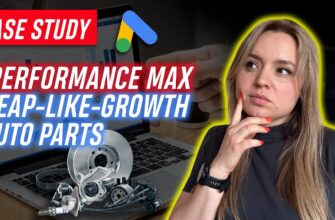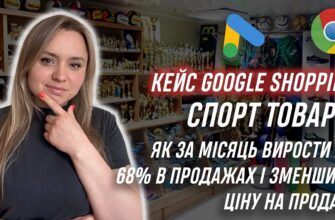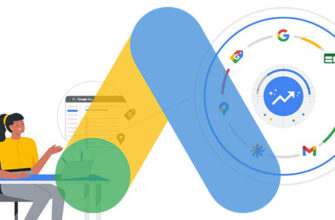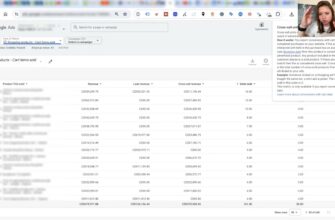- Brief description of the project to be analyzed and modified
- Specifics of performance max work
- Determining the quality of traffic by looking at the performance
- The problem is scaling on a budget
- The “maximum conversions” strategy in this campaign
- The second option is “target profitability”
- Reasons why to connect call tracking
- Analyzing results in the “Goods in Purchases” report
- Dealing with significantly spendy categories at low conversion rates
- Low conversion rate, performance is pouring in the money
- How to edit performances to optimize your campaign
- Editing signals
- Remarketing Audience Analysis
- Where do I see if the signals are being used?
- Bottom line. What will need to be done
Hello. My name is Yana Lyashenko. I’m a Google logger. Even though you probably won’t like my voice, we’re going to do a little performance max breakdown today.
Brief description of the project to be analyzed and modified
We have an online store, you might say agrochemicals. This is Prom.ua here. And this nuance will be very interesting. I’ll touch on how we have the challenge that there are analog stores that are making more money on the same ad spend than a given advertiser. We’re going to look at how to figure out where you can immediately see if the performance is picking up the right traffic or not. But before I start, I’d like to emphasize why we’re going to pay attention and where we’re going to find at least partial information about whether a performance picks up traffic or not.
Specifics of performance max work
See, performance is the tool that this Google artificial intelligence uses and it has its own peculiarities, specifics here. It doesn’t understand at what cost it should sell the product, what’s your margin there, your markup, I don’t know if you’re getting calls or not, if more people are buying through phone calls and stuff like that. He doesn’t understand all that. He also treats them as just some numbers, figures, how to put it correctly. Why?
How many calls and sales will I get by ordering contextual advertising from you?
I need to calculate the conversion of my website Describe
the task
in the application
Calculate potential ad revenue Google
contextual advertising calculator

Because it even has metrics that are about revenue, they’re called conversion value. That’s it, that’s our revenue, conversion value, purchases. Our sales he calls just conversion, it’s just a numerical value of some kind. So you should always control in your advertising account what he is doing with your traffic. Because your volume of conversions, sales, revenue is directly dependent on the volume of traffic. It depends directly on the volume of clicks you generate. Performance is so far the only advertising tool that can directly generate pretty good volumes of direct, good traffic to a site. Performance uses different targeting mechanics than the usual, ordinary Google shopping. And it can produce results that are proportionally bigger, more convenient and easier than your fiddling around with the usual merchandise.
Because it knows, if we collect enough analytics, what kind of query or what stage of the sales funnel to get to in order to catch a potential user under our indicators, what we want from him. So we have a non-alternative option. But since this is artificial intelligence, it is important to us what kind of traffic this traffic will be, how high quality or low quality it will be. And your future scaling will depend on that. That’s key. It’s always key, because so much depends on the quality of traffic.
Determining the quality of traffic by looking at the performance
How can we determine this quality of traffic just by looking at our performance? By conversion rate. If our conversion rate is at least 1.5%, we can say that the quality of traffic is good enough. And you will be able to scale further without any problems. If we have a conversion rate in our case of 0.48%.

It just shows that those 1.5 thousand clicks there in 14 days are some traffic, but it’s not clear what kind of traffic. It’s probably either dispersed between different products and you have a problem, either with the site or with the product to make the conversion. And this is Prom, it’s been working every other week for some reason with a 504 error. That is, people get to your site, but they don’t see anything there, 504 error. Or the real problem here is that the traffic is too wide, the wrong traffic, and there are a lot of different points on which this performance can be broken down. We’re going to go over the basics here. Because this is a basic breakdown for the big picture. So it is, first of all.
The problem is scaling on a budget
So in our case, scaling just by, for example, the very budget, you see here is limited by budget, we can’t do it, even if we tap here, it predicts to us an even bigger increase in the price per conversion.

The budget, well, we don’t have such a big budget there, 400 UAH will be. The cost will increase significantly, right? In some niches, for example, this whole cost of conversion, it already makes up the entire margin on these products. We have agrochemicals, fungicides, pesticides, and on and on it goes, mordant. And now look at the product range. That is, we can’t increase the volume of traffic just like that, at the expense of just the budget, because it’s the most elementary thing: we increase the budget – the shows grow, and then the clicks follow.
But the conversion rate already here tells us at once that it will not work just like that. What is this problem? This problem can relate to something strategic, like the chosen bid strategy that was used here, that it worked for a very long time, it failed. The product mix, the size of the budget, the actions that the person in the advertising account performed. Here even the moment when the performance went into the auction has an impact. Because even if you run, for example, two advertising accounts in parallel, pressing “enable advertising campaigns” at the same time, you should realize that they do not enter the auction in the same way, absolutely. There’s a lot of nuances that can affect that. We have to deal with it. We’d like to, well at least keep more, reduce the cost of those conversions, improve the quality of the traffic. You see, here to increase the number of conversions.
The “maximum conversions” strategy in this campaign
Can it be done on this ad campaign? Yes, but you’ll need to modify it. The first thing to realize is that you have several formats for editing this performance. One will be as simple as possible, blunt, and accordingly the result will be quite so unstable, specific. And the other will be a little more complicated and you will have to work with it. Which one is the simplest, dumbest, most primitive? Here you have a “maximize conversions” strategy. What does this strategy do? Briefly. Algorithms have not changed for a very long time in this strategy. You have a certain size of advertising budget, there is a structure, something else. He is trying to find the maximum number of conversions for this budget. This maximum number of conversions is not always a budget, to be honest.
Here, if you wanted to generate some much cheaper conversions right away, you had to start with a much smaller budget. Well, this is the specificity of launching such strategies from zero accounts. Or you need to keep some specific nuances there. With this budget of 250, I think they even increased it. We can look in the change histories for the last budget increase. Here are the budget changes, it seems here increased amounts of recommendations 220-250. That is, on average, somewhere around 200 UAH we had. That for this amount of budget money, with such a strategy, then your actual CPA is approximately and there is such somewhere around 400-450 UAH. It is a little bit cheaper here. That’s great, that’s great.
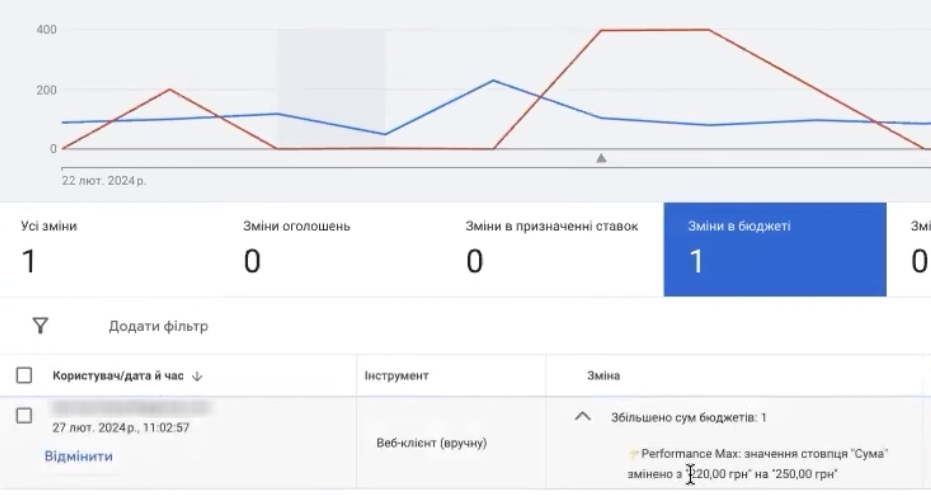
Performance found a much cheaper price per conversion, but those ratios always happen. I don’t know where you look, what tools instruct how to run to maximize conversion rates. There is always such a ratio there. And now, in the future you have purely technically you need to understand what next? That if you want to scale this result, if you just increase the budget, the proportion will remain the same. That is, the actual price per conversion will build up very quickly. This has to be fixed. If you want to keep this price per conversion, with this strategy, you have to realize that in order to continue to generate, for example, the same number of conversions (we have, for example, 10, divided by 14 days. How many do we get? On average 0.7 conversions approximately) you need to proportionally increase will budget.
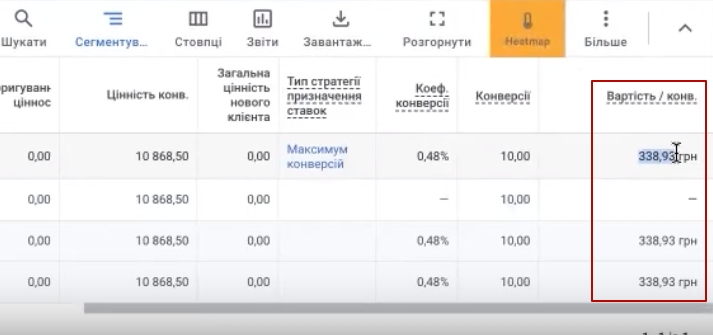
Look, you now actually have almost 340 UAH price per conversion, and the budget is 250 UAH. That is, in order for you to proportionally generate at least one sale per day, you need to do what? That’s right. Set the budget so that to this actual cost per conversion, respectively, to have a higher number of conversions. Stupid strategy, primitive. There’s only one big nuance to it. The price per conversion in this case is very difficult to lower. Because you don’t have the volume of conversions for statistics to find cheap conversions among them.
I mean, conditionally, stupidly, what do we do? We set our actual CPA in the settings of this ad campaign. Oh, yeah, wait a minute. “Settings” is the new interface. I’m looking for the old settings here. In customization here your goal is to put actually CPA and increase proportionally your advertising budget. How many conversions are you ready for at this price. If you want five conversions, you need to budget for six or seven conversions. Stupid, primitive strategy. And lo and behold, here’s the “maximum conversions”.
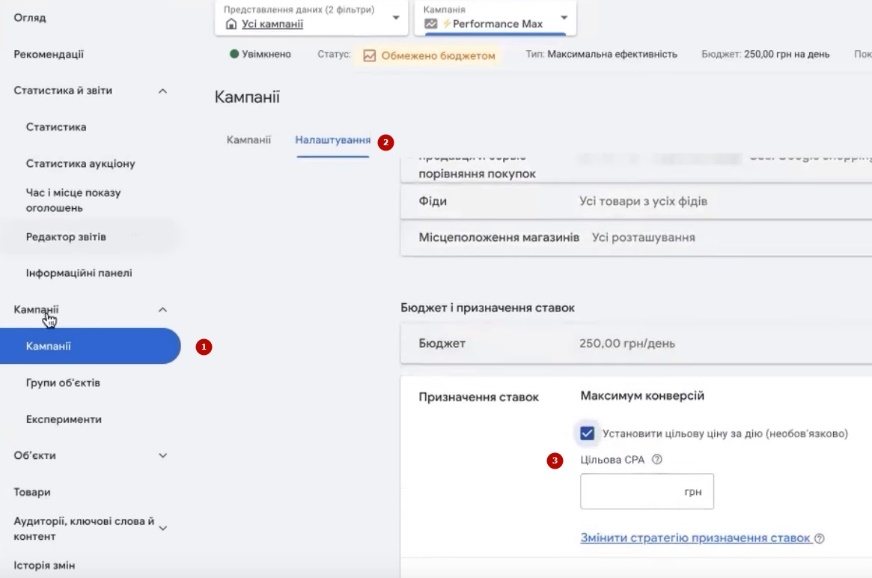
We’ll put a self-imposed cap on it. The budget has to be increased. The only disadvantage of this strategy, or rather a big disadvantage, is that the smaller this statistical sample, the worse this result will be.
And little more, if you want, for example, to generate these conversions of 50-70 UAH. Well, let it be 150 UAH or up to 200 UAH. For example, up to 200 UAH, then all the more with such a strategy you will not succeed. Not only that, on strategies “maximum conversions” target price per conversion, it will always generate significantly less conversions than it can be done on my favorite strategy. If you’ve watched the process of creating performancemax, I mainly emphasize exactly the “target profitability” strategy there. And “maximize conversions”, it’s not suitable for everyone. There’s a very long waiting period, A/B tests. It may work, it may not work, 50/50. A strategy that deals with the profitability of a task, it is more substantive, it is more targeted, it is more predictable. It can be used to cut, cut traffic, scale very easily while maintaining the same budget, increasing the budget. It’s much more comfortable to do that.
The second option is “target profitability”
Therefore, the second scaling option will be about already moving to the target ROI, strategy. What do we need to do? If we want to reduce the price per conversion in parallel, for example, by half, just by setting the profitability. I don’t know the actual profitability, which we got, or the predicted one, or the desired one. It’s not going to help us much because this ad campaign is already low quality in terms of traffic generation.
That’s why I was saying that if you put a targeted CPA out there increase the budget. How many conversions you put there, even if it’s 100 conversions a day, it’s only going to get more expensive. Because the conversion, the quality of traffic is very low. So in order to correct this, you need to do what? You need to in the report editor, if you don’t know where that is, here’s the report editor. My favorite report is items in purchases. You can find it here, efficiency summary.

I have a set here, for example. You may repeat this, you may not repeat this report. I just found in the feed, a single criterion for splitting these items, item type three. What do we have here? We have “crop protection products.” Well, here’s “plant protection products.” That’s Ukrainian, Russian for “fertilizer.” That is, we have two categories – “Plant Protection” and “Fertilizers”.

What can we clearly see here? Let’s take the same 14 days. We only got 10 conversions. Let’s take 30 days. At least we’ll get some conversions. Here, by the way, a person has phone calls per day. Of course, if you have the opportunity to upload these phone calls as Google Ads conversions.

Reasons why to connect call tracking
Well, ideally, if you took a call tracker, connected Binotel, Ringostat. You choose it, you connect it, it will work for you. Those costs that will seem to you somewhere wrong, they will pay off for you, because you will elementary see what generates, what does not generate you those phone calls, among other things. That’s ideal. Well, as an option, you can connect call_phones, for example, there is a target, call_phones event in Prom. But that’s a story, to be honest. There if you look at the analytics, what it consists of, it’s not a high enough quality target. Well there were many, often situations where there were many times more calls than these call_phones. Or, for example, there were more call_phones than actual calls, so call tracking, there will be much more of these conversions, a large statistical sample. More if, look, in this topic there’s a season, it’s very short. It’s not half a year.
It is two months at the most, and then the season has already begun. That is, the client is already late with turnovers, as they say in network marketing: “Either the client is yours today, or he is someone else’s tomorrow”. It is the same story here, the more you give analytics at once, the more presentable any artificial intelligence will work. It’s like with GPT chat, you can ask it a question, there write me a description to my product card about a plant. He’ll write all kinds of bullshit. You set clear parameters, what you want in the output, he writes a pretty good text. It’s the same story here, only it works on conversions.
Analyzing results in the “Goods in Purchases” report
What can we see here? We can see that we have, well, for example, let’s say it’s 2 + 7. That’s 9, right? More than half of the conversions were done by crop protection products. That said, you can see how much bigger the budget is. I mean, how much is this? Three, almost four thousand hryvnias. Right? 3800 isn’t even half of the total amount spent. Well, the conversions are not proportional to the budget spent. Plus conversion is really low. But the fertilizers on which Reformans himself spent there 400 plus 400 = 800 to 1000 UAH, not only there is some “fertilizers”, you think that this is the average cost. That is, here one and the same fertilizer could work in two feeds.

Don’t think that there, for example, Ukrainian just worked out worse. 2,6%. Well, there’s 0.55%. 2.46%, for example, is the average rate. What do we see here? You and I are seeing that “fertilizers”, they’re clearly underperforming something. Well, I’m not sure that crop protection products have a lower keyword frequency than fertilizers. It just happened that way. It was easier to put it into shows, it went from there. If we add a fourth level of product, and for example, what do we see?
Well there’s not a lot of conversions on the same clicks or the same, let’s go, cost descending. Let’s see where performance invested the money. Weedkillers, herbicides, insecticides, fungicides, herbicides. See, that’s almost exactly what we need. The expense side is there, but there are no conversions at all, if you can see here. Here they are.

I know what is displayed here, for example, “seed dressing”. Here, look, here for example seed dressing looks like something that spent money, brought nothing. You do not view it as there, for example, Ukrainian is not effective, but Russian-language feed is effective. Because in fact, when a person buys a certain product item, it can be displayed in Russian or in Ukrainian.
So here it is ideal to look even by product ID in order to understand for yourself what was effective or ineffective. Because you see here, it is not a fact that you, for example, leave only the Russian-language feed, increase traffic to it, and it will generate a lot of conversions for you there. No, it’s just such a breakdown is given. Most likely, the goods spent money both ways. That is, the problem here is not in the Russian-language feed, in the Ukrainian-language feed, if anything. The problem here may be the product.
Well, for example, let me select “crop protection products”. And I’ll take the same crop protection products. Filter the dressing agents and we’ll take, see item ID “57”. Here you see, that in Russian-language, that in Ukrainian-language, the commodity item just spent money. It’s the same product. It’s not a language version. It’s the same product.
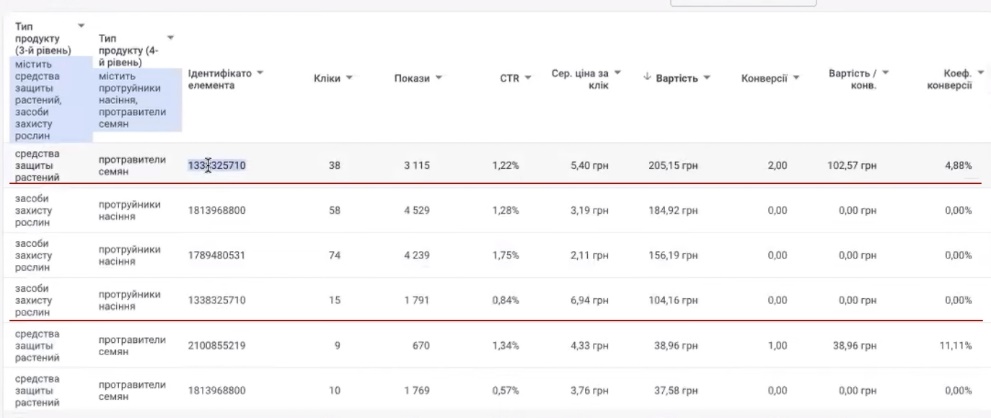
Just in general generated 38 + 15 clicks, spent 300 UAH and got two conversions. That is, so that you, when I show you all these things, so that you do not think that there is so to speak, the Ukrainian or Russian version there somehow does not work well. That’s not how you should view it. It’s just the breakdown format we’ve been given based on the feeds that are uploaded.
Dealing with significantly spendy categories at low conversion rates
So going back to our this. We can see that there are categories that were spending very significantly but were giving either low conversion rates or something like that, and that’s something that you’re going to need to work with.

“Stickers”, for example, see “stickers”. They themselves spent literally for 30 days – 200 + 90, 300 UAH for 30 days. 300 UAH divided by 30 days – you get 10 UAH per day. And the price per click you have an average of stickers, well, let’s take the average, there 2.50 UAH. Divide by 2.50 – you get only four clicks per day potentially possible. Here, of course, they can be much less. That said, the conversion on your stickies, well let’s define. 71 + 39, where we summarize all the clicks on 110 clicks. Let’s take our one conversion on these, on stickies divided by these 110 clicks. We get a conversion rate of, what is it here, 0.9% quality of this traffic.
It’s not a problem in the feed of language or whatever. Well, like, it’s very hard to say that a person came to your site on Ukrainian fungicides, thought, “God, what a language,” and left. No, there are slightly different elements at play there. 0.9 this conversion rate means that we need 110 clicks to get one sale. And you could get a maximum of four clicks a day. So what kind of turnover of 20, for example, 10 or 100 sales per day can we talk about, when you spent so little money on a particular category. That’s the first point.
Low conversion rate, performance is pouring in the money
The second nuance is what we can see, we remember we still have a very low conversion rate. That means that this number of clicks is not net clicks on our products in terms of very targeted traffic. It means that most likely performance was somewhere pouring money into unnecessary traffic, or untargeted traffic, or traffic that doesn’t fit our KPIs.
Let’s put it this way, on traffic that doesn’t fit our KPIs. Our KPI is, for example, there are 20 sales per day, 150 UAH price per conversion or 200 UAH, or 50 UAH, or 60 UAH. Right? He took something that was not targeted. Additionally, the man himself told me about it, saying that there are some competitors here, for example, this one here, this one here, this one here, this one here, if we pay attention, here he has a share of 27%. 25%, 25%.
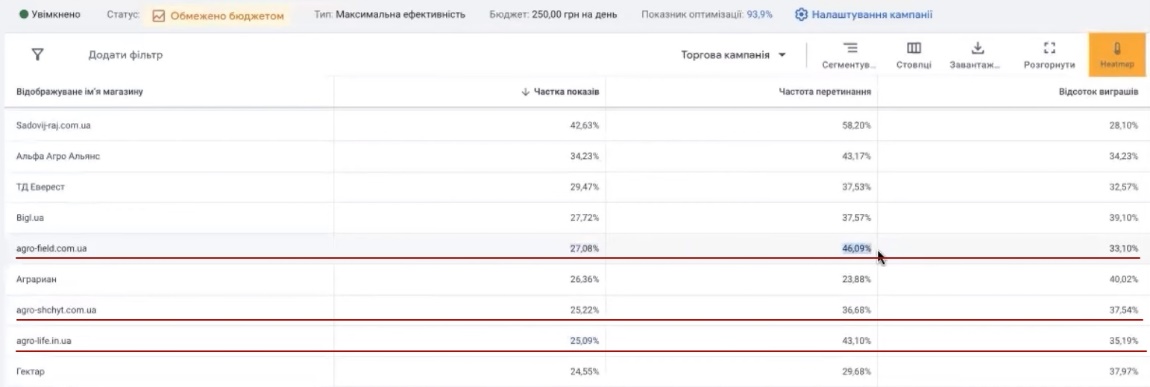
The frequency of keywords or search traffic intersecting with our feeds, you see, the maximum there, 35% on average somewhere, by these three competitors for example.

And we’re at 46% in the auction stats. Only the Prom is first. That’s it, we’ve “won at life” but with very few sales. And we know that these competitors have significantly more sales per day for the same budget. That tells us one thing, that all these clicks that we’ve been picking up with you, right now at this moment, Google is pouring them somewhere on the left side. You’re not going to see that here. In the block of these queries, you’re going to see something that you have, well like it can be targeted, it can even sell. And everything here can be targeted. But it’s still siphoning off that traffic somewhere, you can see that on the basis of the auction statistics. This shows that this previous strategy of bluntly going for “maximum conversions”, it is more likely to be ineffective for you as well.
A low conversion rate indicates either broad traffic or you’re not finding an adequately targeted audience. How do you determine this? You need to take your product and google the broadest queries. You need to find the moment at which, or rather the query at which you would see this chain of auction structure. When these competitors together with Prom occupy a very large part and you hang out there together with them. Because if you Google your target query, there is “fungicide for so-and-so”, or there is the name of this fungicide, and you see more of these guys in this rendition, it means that this is not the query in which performance is being placed.
How many calls and sales will I get by ordering contextual advertising from you?
I need to calculate the conversion of my website Describe
the task
in the application
Calculate potential ad revenue Google
contextual advertising calculator
So it’s not the query that performance is putting your resources into right now, it’s somewhere in the left traffic. It is desirable to find this left traffic or just take and spend a day or two there, you google different broad, not broad queries, you can even go to the keyword planner to try to enter your very broad queries. Just the site to try to find exactly what that keyword prediction might have something untargeted in it and minus it.
You can minus that, for example, exact matches, by submitting a request to google’s support. Or you can run a regular sales and advertising campaign. Spin it for at least two weeks, but at the same time filtering out and minimizing the target traffic every day. After two weeks, you will have a certain core of traffic that is not bad enough target traffic, on the basis of which the performance will be targeted again. And it will be able to work normally, adequately. Of course, when your season has already started and you are already on fire, well, waiting there to collect some traffic, it may not be appropriate enough. So you may have to try to edit these performances in fire mode.
How to edit performances to optimize your campaign
How exactly do you edit them? We need to understand with you whether he can find something quite good in some segment in terms of traffic. Based on those conversions, it’s very hard to figure that out. For example, “dressing agents” or “seed dressing”, can they do enough conversions or not?
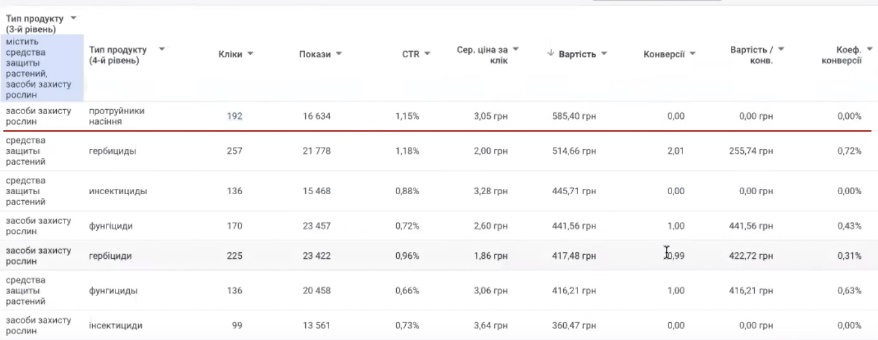
It is necessary to try either to break them down into some segments, or at least at a minimum in this campaign in the performance to try at the level of groups of objects. At least here I would ideally recommend it in different campaigns. Because here we have a breakdown going into remarketing lists, something like that. Well, they give you shopping.
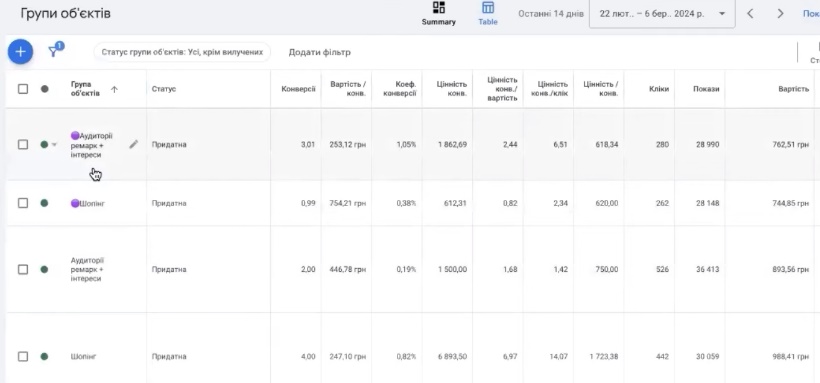
I don’t know why they call it, like, shopping. Because it’s the same story, it could be there and KMC-ka and stuff, but so be it. Instead of breaking it down like that, try to break it down, try to break it down by category and for each category try to set a personalized signal.
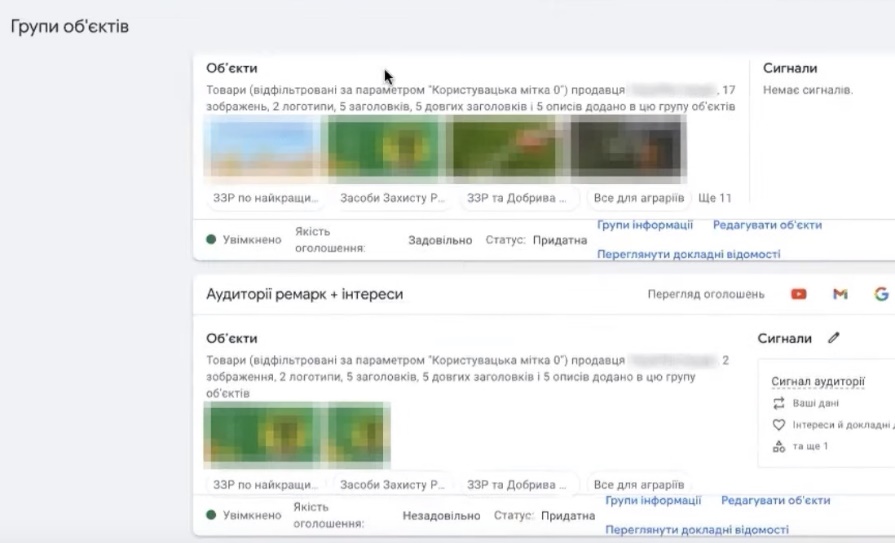
That is, this fellow performer is somewhere pouring money into something, or rather your budgetary resources. It also asks you to increase my budget even more. At the very least this signal has everything in it, to be honest. There are remarketing lists here.

I have nothing against it. Wonderful, wonderful, but there’s “Home and Garden,” “Over Lawn and Garden,” “Gardening,” “Household.” “Struggling” fits. “Home and Garden,” but what is “Home and Garden”? There could be, just so you understand in the category “Home and Garden” could be the same cup included, for example. Or I don’t know, some watering can, I don’t know, some flowers, something like that. These special search ones, they don’t work well here anymore.
I would recommend that you try the following combination. I would divide them into different groups. That is, in each of the groups of objects, for example, separate dressing agents, separate something else, something else, something else, something else. Even within a single campaign, if you have a very limited budget, just for a day this budget. What are you doing this for? To break down previous analytics.
You don’t do it because it’s the structure that’s going to do some incredible miracle in your campaign. No, it’s just something that’s going to break a little bit of what he had before. And before that, he had what? He had a conversion rate of 0.48%. That’s what he had.
Editing signals
What will you do in the signal? For example, you have dressing agents. You know what queries will be searched for these dressing agents specifically for you. Put at least 10 keywords here. At least 10 that relate to weedkillers.
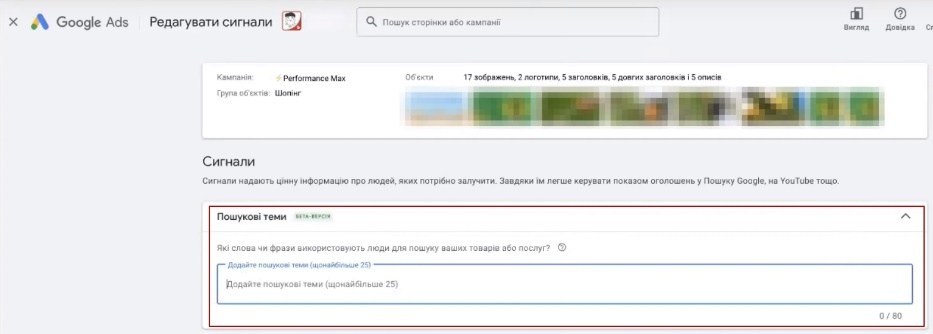
You can add remarketing lists. But I would recommend either targeting former customers or from the fourth analytics to take that add_to_cart, something like that, because the dinremarketing lists on Prom don’t work correctly enough. So, just so you understand.
So, what else do we have here? We have the most conversions in 30 days did this shopping, see. Right? Even here, the profit margin is 6.97. What kind of shopping is this? Oh, that’s without signals, see, that’s without signals. He made the most conversions. And the conversion rate now, if we have that metric here. What’s my point? I’m talking about the signals. And there’s a conversion rate. Wait, I missed it somewhere – 0.82%. There’s 1.05% in remarketing here.
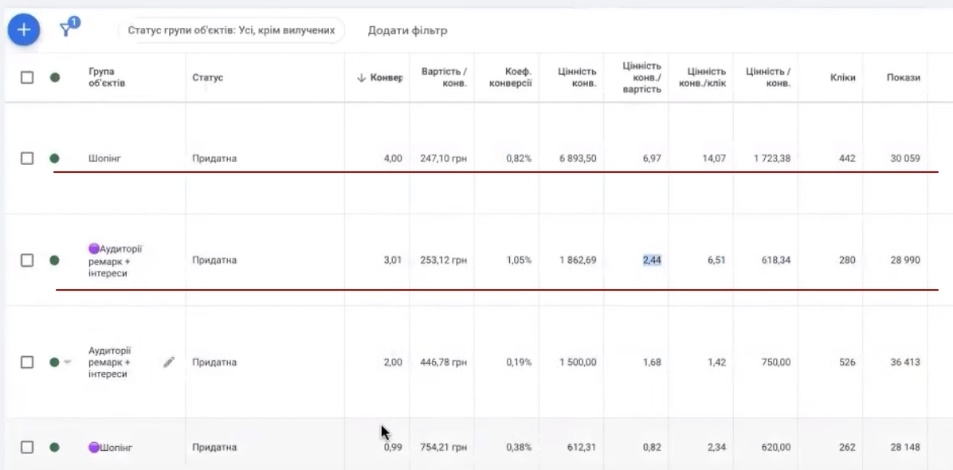
But the profitability is very, very bad. These two are really unprofitable. They’re just making things worse. So I’d clean these ones up, your Home and Garden and stuff. You can keep the same remarketing. These are the ones, I, for example, I would leave the same without the… Anyway, there are two formats here. In order to keep the same budget limit restriction, you have to remove what is feeding you money. You have to identify who is feeding you money, because this structure is not clear to me. If you want more anyway, you need to set signals.

Anyway, the point is, look, if you try to improve this conversion rate at the performance level at a very hot pace, you have to take away all the things that are weak right away. It’s not effective. What is strong, it would be desirable to strengthen it. How exactly to strengthen it, in this case, you can’t make an adjustment. Right? You need to either give up that signal, or set a signal that is more universal, or break it down into groups of objects. I call the options by these types of goods, there “insecticides”, there “mordants”, “fungicides” separately. And for each of them set a signal.

Or even not to set a signal, because you have these keywords in the very titles, the names of these product lines. And adjust it all, that is, track what is effective, what is ineffective. For example, for example, let’s take here, I think we have this shopping, four conversions made without this dot shopping. Here we go to “information groups.” And then you see which of these works well, which of these works badly. Let’s see, here is the chemistry in Russian, for example, it has converted more. And there approximately it does not correlate in any way with this whole story, the spreads will be just a very long spread on the type of goods.

What do we see here? We see that the “means for defense”, you see, here in general is very low, in general in 14 days or 30 days very little money has been spent here. So what to talk about. The conversion rate just on “remedy” is 1, 15%, let it be fertilizer 5.88%. Three conversions, there you go. What do we need to do? We need to strengthen it somehow. So your task is either to remove those groups of objects that have lower conversion rates there.
I wouldn’t rely so much on remarketing, given that there’s also Home and Garden and other categories there. It would have found that anyway. If you have, for example, some expensive category that spent money, for example, “seed dressing”. You see, 172 UAH is already the limit for you, then you should exclude it from here. Add this category to a separate or a group of objects of this campaign, or even to a separate campaign and work on the signal from it separately.
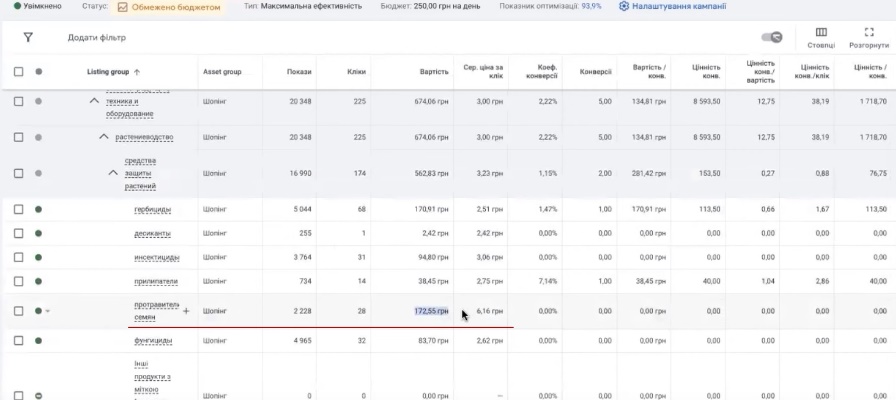
Because the signals that your performance art uses before, they are ineffective, for example. By excluding some group that is ineffective in this campaign, all the rest of the money will be allocated more appropriately to other categories. But you have these groups, these facilities, there’s a lot of them. There’s only four of them here. Each one reserves a budget for itself, that’s the cost. These two should be eliminated altogether.
Remarketing Audience Analysis
Here’s the remarketing audience. Come on, let’s see what kind of remarketing, what kind of audiences are sitting there. Well, they are not pure remarketing, let’s do that. And we can’t look at the auction statistics on them either, to understand if he’s really pouring this targeting in here somewhere, because what fits here? Former buyers fit here.

Well, all the visitors, well, it’s possible as an option, but well, it’s all crammed in here. You want to keep it. It will not be bad even if there are two performances: one for remarketing will work, and the other without a signal. You have the kind of niche where no signal will do the trick.
Look, this whole story is done only to try to get closer in targeting to these competitors that we were talking about. If the goal of the last seven days is to get closer to them, then you can’t do it in one campaign on the basis of those old analytics. In different groups, objects are targeted differently. In our auction statistics we have no possibility to select, for example, a group of objects, we do not even have a possibility to segment by this. You see?
Well, I mean, so either remarketing should be put into a separate campaign, I mean a signal, and then play with the product range there. And here we should leave it without a signal and then break it down into separate blocks, add signals, try to play with it. All of this will also affect the quality of traffic. Or filtering out traffic, like I said first, from regular merchandise. Or looking for potential minus words that offset that, that’s all this, the results that you have here. Well, it’s a big block of work. If you’re in the beginning of the season, it has to be done at a rapid pace.
Where do I see if the signals are being used?
More audiences that you can add to the signal or they are used. Let’s see if they are used by the system or not, you can still see in this section “Statistics”. Take 28 days, because in 7 days it has little relevance. And look at what you have here. See, it’s very important to go by the index. You see, the higher the index, the better the audience fits you. See, this uses, what? 1, 2, 3, 4 blocks of these signals. And the share of clicks, this one generates a high share of clicks. This one generates a high share of clicks. This one generates a large share of clicks.
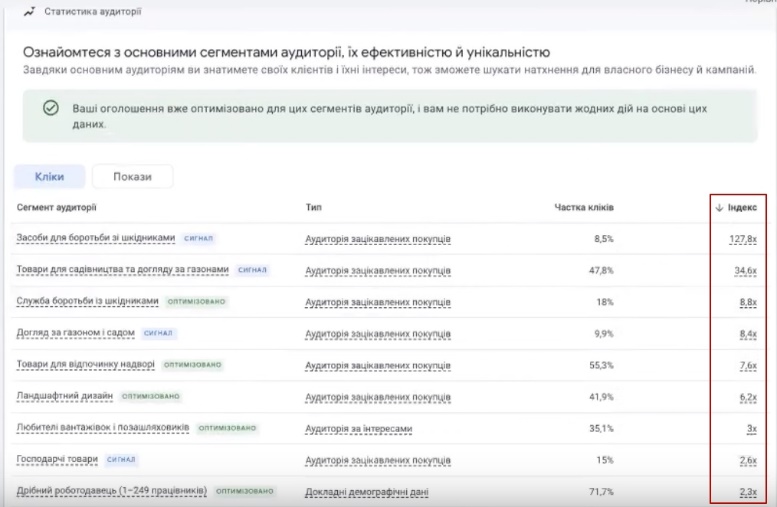
Depending on what is here “Everything for home and garden”, I will assume that it is more in this category, if your client is an agricultural client, it is a little bit of an inappropriate story. So seeing this analytics you can decide to adjust the same signal. Something to remove, something to add, depending on the index. For example, this signal isn’t effective enough for your niche “Care for”, well that kind of thing, very little story. There’s “pest control.” But fertilizers, they might fall into a slightly different category. Right?
Bottom line. What will need to be done
So if you summarize that, what would you need to do? Look, the first option with the highest conversion rate. But consider that it may be more expensive. The second thing is you need to figure out where the performance traffic is pouring in. This can either be done by googling queries, finding what might be draining your funds. Ask for this traffic to be mined through Google support. You write a request to them – “I want to mine exact matches, such and such requests”.
The second thing is you try to break that down into categories, into product types. Perhaps on the IDs of some products in order to find something that could just convert stupidly, showing what wimps just eat up this traffic. At the same time do not try not to emphasize the Ukrainian-Russian version of the feed. Because in fact it is a priority. That is, this product position, it is in Ukrainian, Russian, and she spent for 30 days 448 UAH for both versions, and found only one conversion with this product position. You can certainly add the name of the product, here is “Microfertilizer NPK” 118 clicks, here is 268 UAH. “Koragen insecticide” and here it goes. “Fumigant” – 5.40 UAH in general price per click.

Look, the cost per click is very expensive, high here. It’s going awesome. You need to either separate for each category within the performance, set your personalized signals if you want to speed it up a little bit. You can use remarketing lists, but I would put remarketing in a separate performance, and there would be signals that would intertwine with remarketing lists, because without a signal, you’re still doing fine.
The second thing is I would definitely look at which ones are weak. I would monitor daily or at least once a week what the weak one is eating up money, but not converting it. I would simply exclude it or put it in a separate performance. This is such a story in the emergency adjustment mode, if you need to raise the conversion rate very urgently. Or you have patience, filter traffic in a regular product, generate a sufficient amount of traffic for each category and only then return to performance. Or an option like this.
An important nuance. I do not say, do not emphasize directly step by step – 1, 2, 3, 4, 5 what to do. I do this on purpose in almost any niche. So that it doesn’t happen that someone else can copy the strategy and you would have it, well, identical to your competitors. Because if they are identical, why would you need additional competition with the same algorithms or the same sequence that others have.
Once again, let’s fix the fact that others can have one performance and it converts better. We’ve gone over this with the person before, that not all of them are very awesome at having conversions. One of them just has those conversions. He seems to apparently have a much higher percentage of shows here as well. That’s only because his performance art has higher conversion rates.
I mean, if you go into his ad account, look at it, you’ll see that the quality of traffic that performancebase generates, it’s much better. It’s not just these signals that affect it, there you either set it right or set it wrong, and there he is on a different platform on Goodreads, unlike you. Yeah, his remarketing lists are going to work a little bit better than yours. But it means a lot about at what point the auction came out, what the performance was emphasized. If you take even the same product items, you’ll see that you have different numbers of clicks on them, different traffic, different conversion rates. If you’re already in a situation where you have it low-conversion, you’re going to have to play around with that to make it more conversion.
And don’t forget about importing phone calls here as a type of conversion in order to give a large statistical sample and to see what it generates, what it doesn’t generate, respectively, the efficiency in these volumes and scales. If you have a situation like this, you have to pick that performance. It’s like a tractor that won’t start and you have to take it apart. But your neighbor’s did. You bought from the same supplier. There is no repair or you come to a service station, there they will look at what is wrong in that tractor, you have to find the cause. It’s the same story here. Only here Google itself will be helping you. You’re going to have to redesign, try different grouping, different budgets, different signals in order to figure out where that scaling point in conversion rate is going to be. Well, and I would also say that sometimes in “maximizing conversions” it can also be to blame for that low conversion rate.
If you’re using a strategy… Gosh, not a strategy, it’s an attribution model, based on data on maximum conversions it’s always tight. It’s on profitability is pretty good. That’s what I mean, a data-driven attribution model.
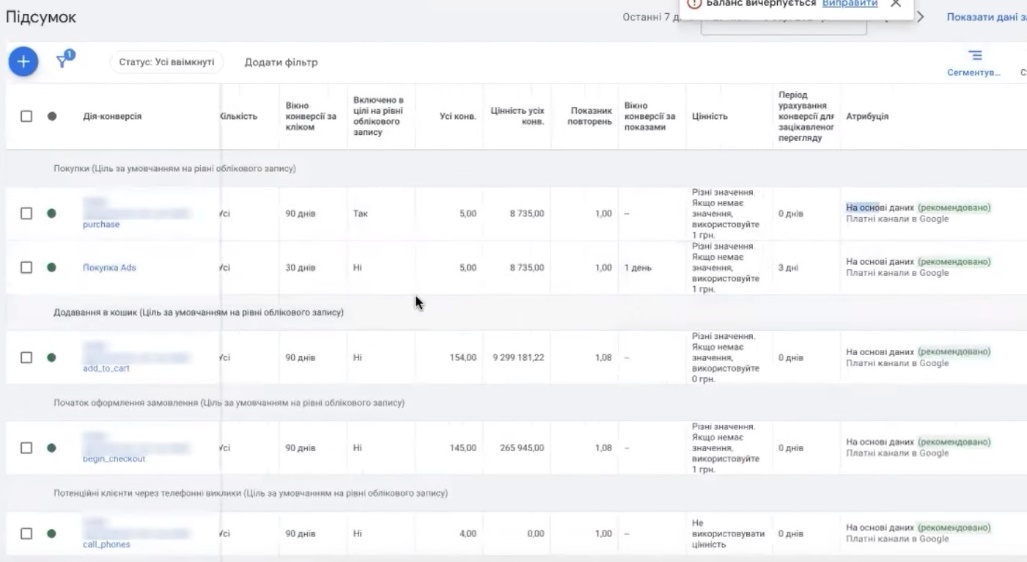
This is where a person listened, a purchase has already been made. You can even try to switch to this same purchase conversion, but change the last click attribution model. And then you have call_phones, but either it’s also on the last click attribution model, or you need to look, maybe it wasn’t recently imported in order to optimize. Move it to primary targets then. But it’s better that you have call tracking. This is a more substantive purpose than just call_phones.
So, to summarize, you have 3-4 options to work with. The first is to continue to bother with this at the maximum conversion rate – also not a bad option, you can get something out of it. The second is to switch to profitability, to exclude ineffective groups of objects, to continue in the same mode increasing the advertising budget.
The next thing is to reshape, the third point, is to reshape the performance by structure, to bring out remarketing separately, to try to divide into different groups of objects, all these types of goods, they will work within the same campaign. Try to set a different signal for them, track who is shown, who is not shown. Those who don’t show up – put them in a separate performance, give them a personal budget. Those who are shown, to control the conversion rate, to improve the conversion rate by eliminating some weaklings or product positions, or their categories, or something like that. Putting them in a separate campaign is a more complex option, yes, of course, it’s also working, it’s more proven. It all depends on how many resources you have to implement this functionality.





